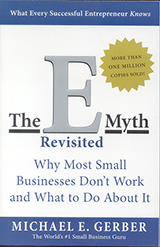My Notes on “The E-Myth Revisited” by Michael E. Gerber:
In a business that depends on you, on your style, on your personality, on your presence, on your talent and willingness to do the work, if you’re not there customers would go someplace else.
In this case, customers aren’t buying your businesses ability to give them what they want, but your ability to give them what they want.
If your business depends on your, you don’t own a business – you have a job. And that’s not the purpose of going into business. The purpose of business is to get free of a job so you can create jobs for other people, to expand beyond your existing horizons, to satisfy a need in the marketplace
The Entrepreneurial Model
Has less to do with what’s done in a business and more to do with how it’s done. The commodity isn’t what’s important – the way it’s delivered is.
The Entrepreneur asks “where is the opportunity?” and then goes to the drawing boards to construct a solution to a certain group of customers problems.
He asks “how will my business look to the customer?” “How will my business stand out from all the rest?”
The Entrepreneur does not start with a picture of the business to be created but of the customer for whom the business is to be created.
The business is the product.
The customer is the opportunity because there are so many wants begging to be satisfied. “What are they now? What will they be in the future?”
The Technician Model
Looks inwardly to define his skills and then asks “how can I sell them?”. This business is designed to satisfy The Technician who created it, not the customer.
The products is what he delivers to the customer.
The customer is a problem because they never seem to want what The Technician is selling at the price he is offering
How to satisfy both personalities?
With a turn-key operation. The entrepreneur builds and plans it. The technician works at the lower levels, writes how-to manuals and then employs a junior person to assume that role and then steps away to write the next manual.
Pretend to create a prototype franchise. The rules:
- The model will provide consistent value to your customers, employees, suppliers, and lenders, beyond what they expect.
- The model will be operated by people with the lowest possible level of skill
- How can I create a business whose results are systems-dependent rather than people/expert-dependent?
- The model will stand out as a place of impeccable order
- A business that looks orderly says to your customer that your people know what they’re doing
- All work in the model will be documented in Operations Manuals
- The model will provide a uniformly predictable service to the customer
- If you create high expectations with a customers first visit, don’t violate them in subsequent visits because customers want an experience they can repeat by choosing to return. Don’t provide a delightful experience and then take it away.
- The model will utilise a uniform colour, dress, and facilities code
How to work on your business rather than in it
- How can I get my business to work, but without me?
- How can I get my people to work, but without my constant interference?
- How can I systematise my business in such a way that it could be replicated 5000 times, so the 5000th unit would run as smoothly as the first?
- How can I own my business, and still be free of it?
- How can I spend my time doing the work I love to do rather than the work I have to do?
Seven steps in the to develop your Business Development Programme
- Your Primary Aim
- What is your purpose in life? What do you want to achieve in 5 years? 10? What do you want people to say at your funeral?
- Your Strategic Objective
- What the business has to do to achieve the primary aim
- What kind of business am I in? Who are the customers? What standards will I uphold?
- How big is your vision? How big will the company be? Exit strategy?
- Your Organisational Strategy
- Detail the structure for the end, now. Write job descriptions, write a Position Contract. You will fill every role initially. Sign the Position Contract for each.
- As you work in each role, refine the tasks in that job and write an operations manual. Then hire someone with no experience so they can be moulded.
- Your Management Strategy
- The process/system you will use to provide customers with their experience (and teach up-and-coming managers)
- Your People Strategy
- Showing the people the idea behind the work that is more important than the work itself.
- Your people want to work for people who have created a clearly defined structure for acting in the world. A structure through which they can test themselves and be tested. Such a structure is called a game.
- Demonstrate the interdependence of the systems on people and the people on systems. Systemising need not be dehumanising.
- Your Marketing Strategy
- Who are the customers? What do they want?
- Your Systems Strategy
- Construct systems for everything. Remember, they are all interconnected.
- Eg for selling: get appointment, make presentation, conduct needs analysis, provide solutions
- Eg information systems: how many calls made? How many prospects reached? etc
